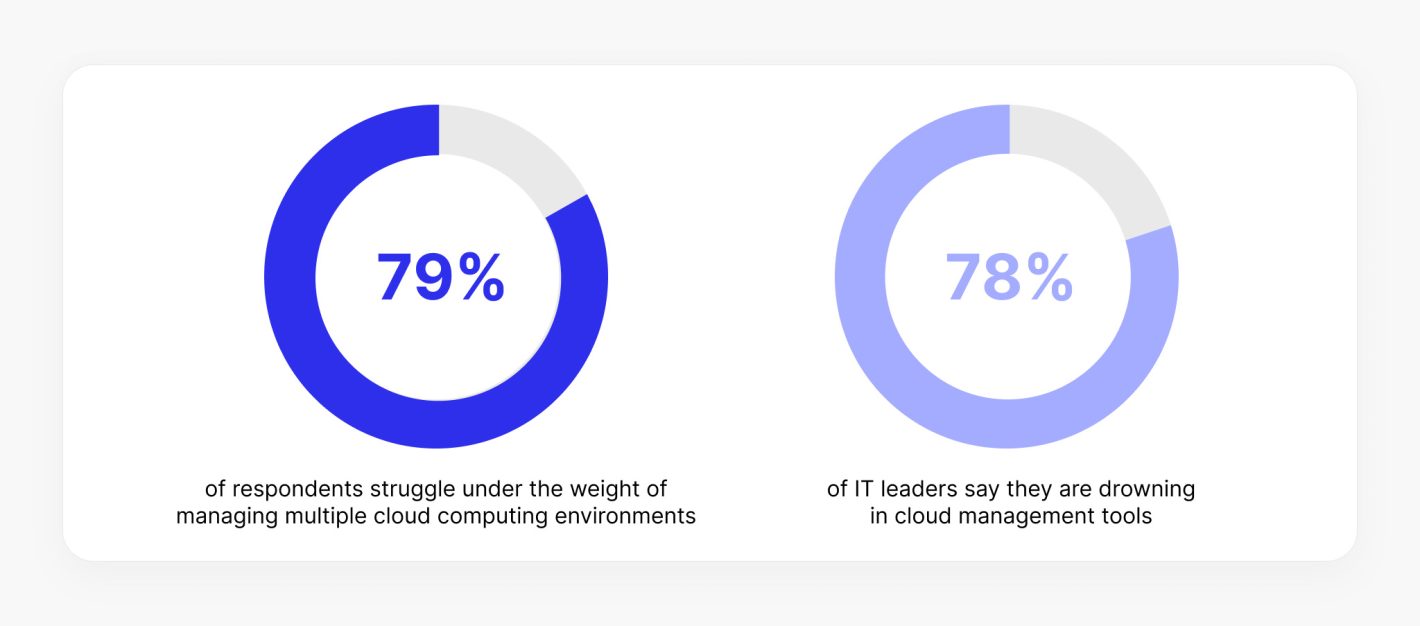Regarding technology, one would probably think of tools, platforms, and architectures. Business leaders, however, speak in numbers: KPIs, ROI, strategic value.
Today, infrastructure and cloud computing, once solely IT concerns, are now significant business considerations. One cloud provider offers better rates, another has strong EU coverage, and the third provides additional benefits tailored specifically to your industry.
How do you choose the right one? Usually, you don’t; that is why more and more organizations are choosing a multi-cloud strategy, trying to take the best of each provider while leaving behind the limitations.
The logic is clear, yet when reality hits, multi-cloud transforms into multi-headaches.
IT leaders often envision a world with rose-colored grasses, where workloads seamlessly operate between Google Cloud, AWS, Azure, and others. This vision usually involves leveraging each platform’s unique abilities and strengths.
In reality, though, multi-cloud brings additional headaches rather than benefits. The real issue isn’t multi-cloud environments themselves; it’s the absence of a clear strategy that transforms them into a chaotic situation. For instance, a survey conducted by CloudBolt Software revealed that 79% of respondents struggle with the challenges of managing multiple cloud computing environments.
78% of IT leaders say they are drowning in cloud management tools, each with its dashboards, policies, and cost structures, turning what was meant to simplify operations into a fragmented nightmare.
Yet, despite the chaos, businesses are not abandoning multi-cloud; they are doubling down on it.
The truth remains that cloud adoption is on the rise more than ever. In times of uncertainty in the global market and the pressing need to meet the business demands for growth, security, and cost-effectiveness, organizations choose to follow a multi-cloud infrastructure strategy. In fact, over 78% of organizations use more than two cloud providers nowadays.



So, businesses still have to manage this new cloud. As the survey above showed, cloud management requires IT leaders to orchestrate many resources but also develop capabilities that leverage existing legacy applications, maintain security and compliance, and keep infrastructure costs in check.
This isn’t yet another guide meant to sing praises to the multi-cloud. Instead, we want to share fresh ideas that we hope will help you cut through the chaos and establish a streamlined, well-governed multi-cloud environment.
Is Your Multi-Cloud Strategy Spiraling Out of Control? Ask Yourself These Questions
So, how do you know if your multi-cloud environment is working to your advantage and not the other way around? Here’s a little questionnaire to help you find the answer faster:
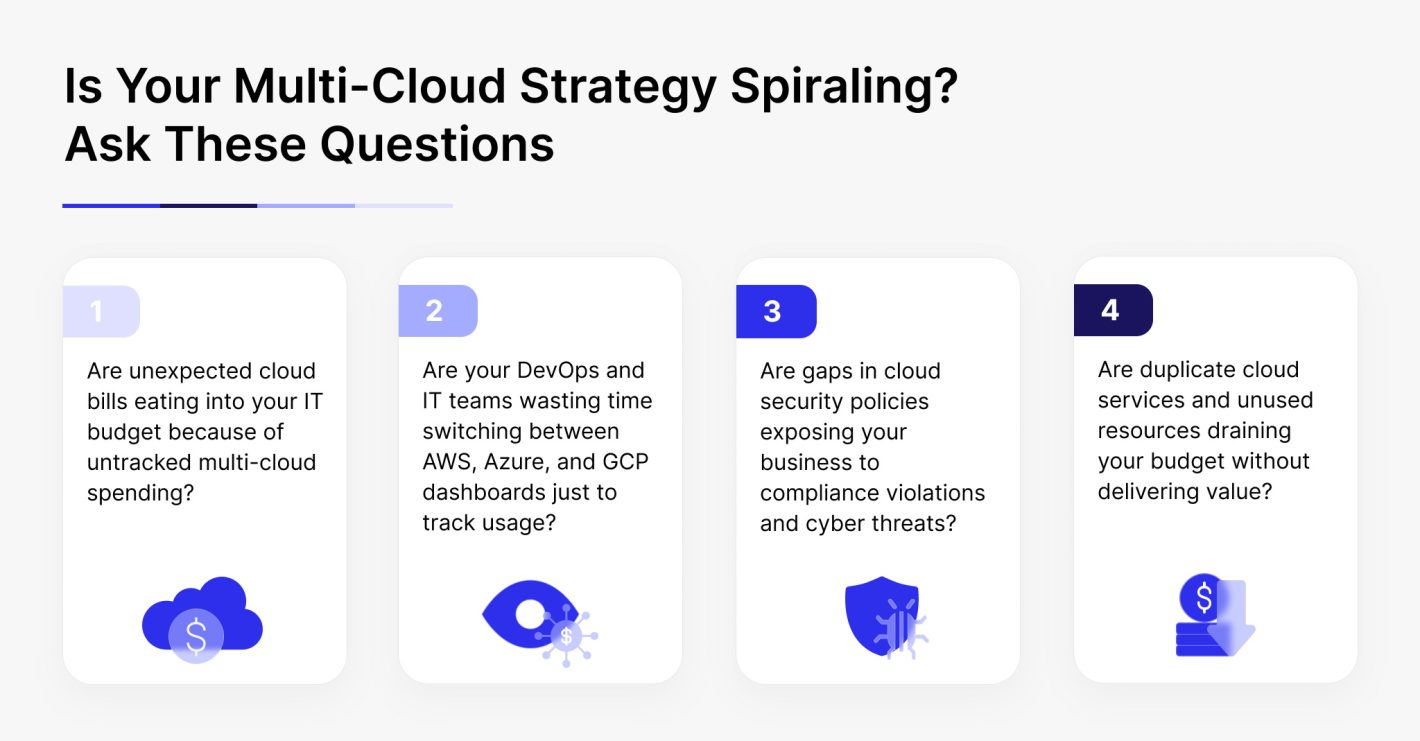


Multi-cloud strategy questionnaire
If you answered “yes” to any of these questions, your multi-cloud strategy might be more expensive than necessary. The good news is that you can transform this chaos into control by implementing the right governance, automation, and visibility tools. Here’s how to get started.
The Common Challenges in Multi-Cloud Environments
Here are the biggest challenges organizations face that become the reasons why managing multi-cloud effectively is easier said than done.
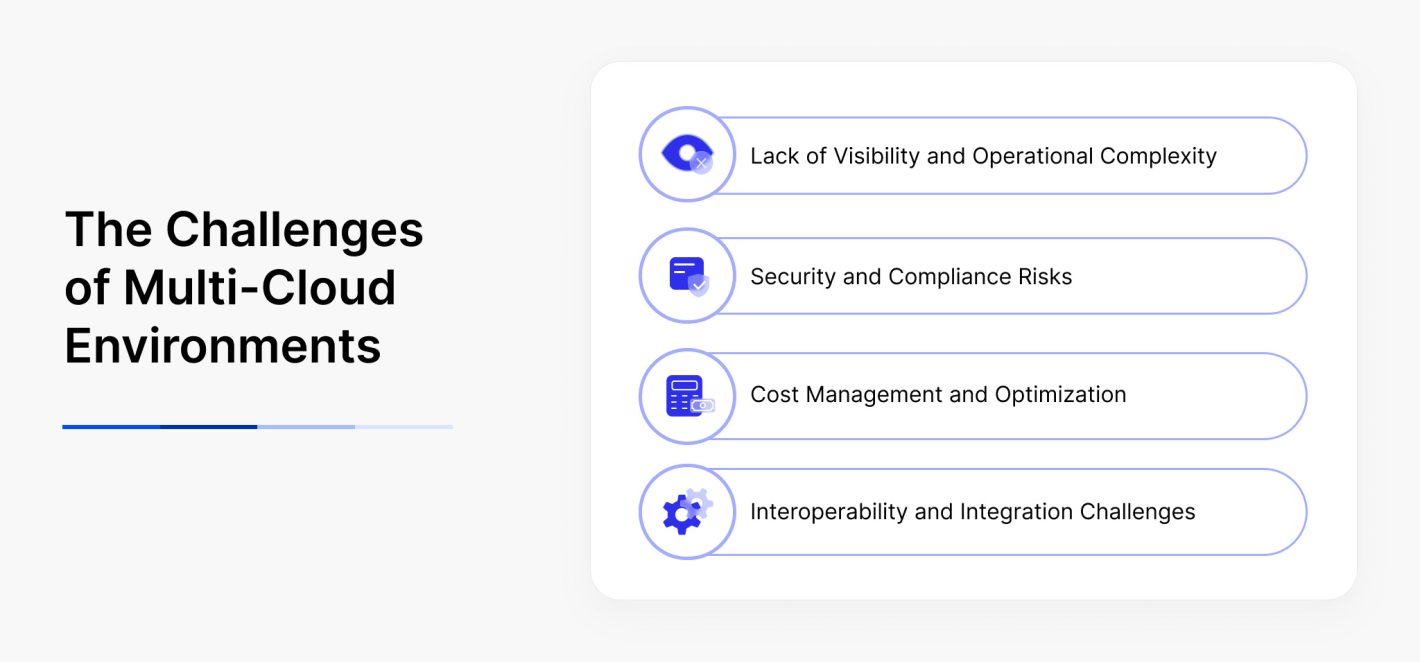


Multi-cloud environment challenges
1. Lack of Visibility and Operational Complexity



Multi-cloud environments introduce fragmented monitoring and governance issues, making it difficult to maintain centralized control.
Why it’s a problem:
- Each cloud provider has its own monitoring, logging, and alerting tools, such as AWS CloudWatch, Azure Monitor, and GCP Operations Suite. These aren’t designed to work together out of the box, making it hard for teams to gain a unified view.
- Resource sprawl: IT teams struggle to track who is using which cloud services and whether they’re cost-effective.
- Increased operational overhead: Managing multiple dashboards, permissions, and policies requires additional expertise and tools.
How to solve it:
- Use multi-cloud observability platforms like Datadog, New Relic, and OpenTelemetry to centralize monitoring.
- Implement automated resource tagging and governance frameworks to track cloud usage across platforms.
In other words, tools like Datadog and New Relic offer cross-platform observability from a single dashboard. OpenTelemetry, as an observability framework, helps standardize data collection across platforms.
2. Security and Compliance Risks



Security in multi-cloud isn’t just a bigger version of single-cloud security; it’s an entirely new challenge with increased risk exposure.
Why it’s a problem:
- Diverse security models: AWS, Azure, and GCP have different Identity and Access Management (IAM), encryption methods, and policy enforcement tools, making it hard to standardize security across clouds.
- Regulatory complexity: Meeting GDPR, HIPAA, PCI-DSS, and ISO 27001 standards across multiple cloud providers creates compliance headaches.
- Data fragmentation: Sensitive data is often scattered across clouds, increasing the risk of breaches and unauthorized access.
How to solve it:
- Implement Cloud Security Posture Management (CSPM) tools like Prisma Cloud, Wiz, and Orca Security to automate security enforcement.
- Adopt zero-trust security principles to ensure the least-privilege access across clouds.
- Use compliance-as-code tools to automate policy enforcement across cloud providers.
As you can see, managing consistent security configurations becomes tricky; that’s why you need Cloud Security Posture Management (CSPM).
Tools like Prisma Cloud, Wiz, and Orca Security help detect misconfigurations, policy violations, and potential threats across multi-cloud environments. They offer automated security scans and compliance reporting to reduce manual overhead and minimize risk.
3. Cost Management and Optimization



Without careful cost control, multi-cloud spending can escalate rapidly, often without businesses realizing where the money is going.
Why it’s a problem:
- Cloud sprawl: Unused or redundant cloud resources lead to unnecessary spending.
- Budgeting complexities: AWS, Azure, and GCP have different pricing models, making cost predictions challenging.
- Lack of FinOps strategies: Many organizations lack a dedicated Financial Operations (FinOps) strategy to optimize cloud expenses.
How to solve it:
- Use FinOps tools like CloudHealth by VMware, Spot.io, or AWS Cost Explorer to gain real-time cost insights.
- Set automated budget alerts and cost anomaly detection to prevent unexpected overspending.
- Conduct regular cloud cost audits to eliminate unused instances and optimize reserved instances.
Implementing a FinOps strategy allows you to monitor the pricing models of various cloud providers. Tools like CloudHealth by VMware, Spot.io, and AWS Cost Explorer facilitate this process. They help your teams monitor and optimize costs across clouds. CloudHealth offers granular cost visibility and recommendations, while Spot.io specializes in automating savings through optimized workload scheduling.
4. Interoperability and Integration Challenges



Seamless integration across multiple cloud providers isn’t automatic: each provider has unique APIs, networking configurations, and automation tools.
Why it’s a problem:
- Different APIs & networking models: AWS, Azure, and GCP use proprietary tools that don’t always integrate smoothly.
- Data consistency issues: Ensuring a unified data strategy across clouds is complex, leading to potential data silos.
- Vendor lock-in: Some cloud services (e.g., AWS Lambda, Google BigQuery) don’t easily transfer to other providers, limiting flexibility.
How to solve it:
- Use cloud-agnostic Infrastructure-as-Code (IaC) tools like Terraform and Pulumi to standardize deployment.
- Implement Kubernetes-based container orchestration (EKS, AKS, GKE) for workload portability.
- Use multi-cloud networking solutions (e.g., Aviatrix, Cloudflare) to streamline cross-cloud connectivity.
Let’s clarify the name-dropping here. Terraform and Pulumi help standardize infrastructure deployments across clouds using code. Docker provides portability for running containerized applications, while Kubernetes (managed services like Amazon EKS, Azure AKS, and Google GKE) orchestrates them. Use multi-cloud networking solutions (e.g., Aviatrix, Cloudflare) to streamline cross-cloud connectivity.
Strategies for Simplifying Multi-Cloud Management
Effective multi-cloud management involves more than simply choosing the right providers; it necessitates a well-structured strategy to mitigate security risks, reduce cost inefficiencies, and eliminate operational bottlenecks. Here is a clear roadmap that we at Sombra use to optimize multi-cloud management for our clients.
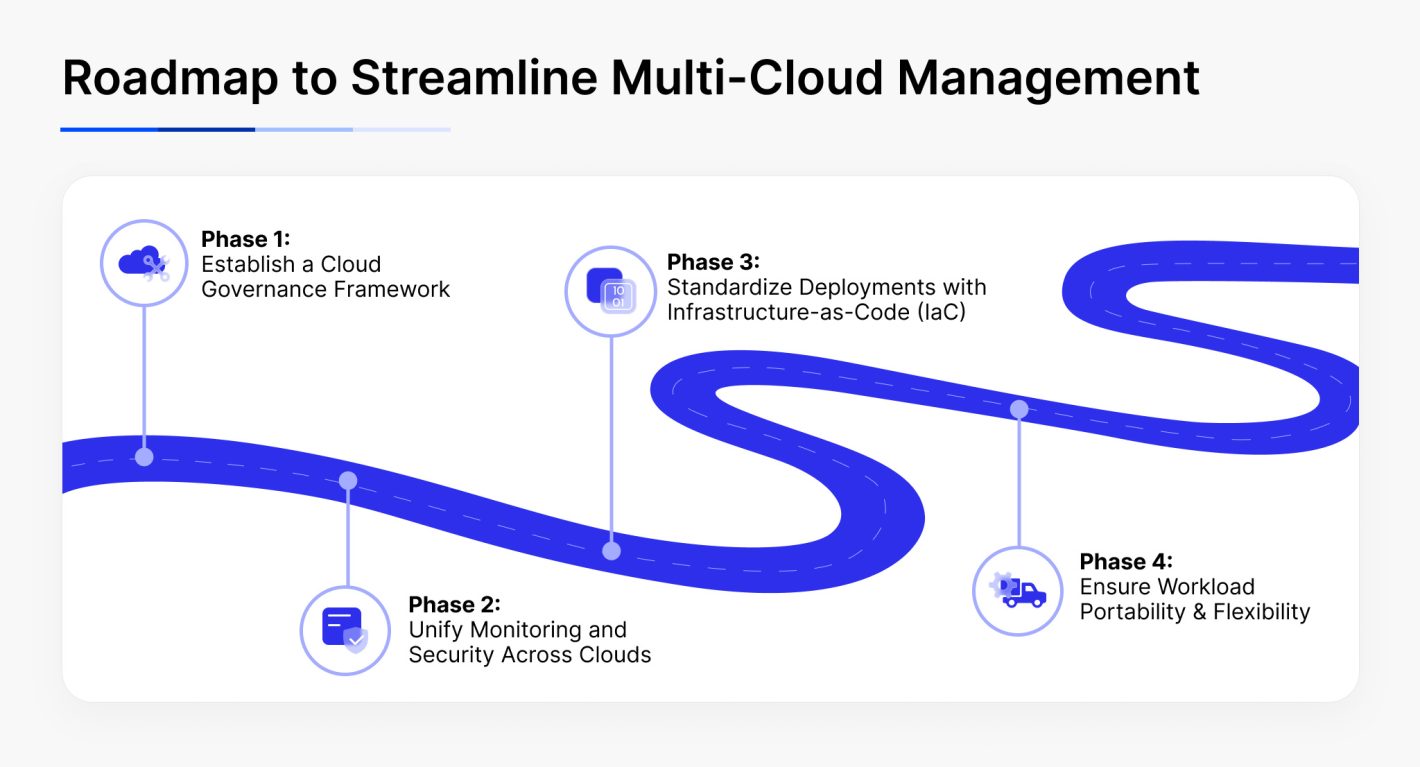


Multi-cloud management roadmap
Phase 1: Establish a Cloud Governance Framework
Without proper governance, multi-cloud environments quickly become unmanageable and expensive. A structured framework helps ensure consistency across cloud providers.
- Define security, compliance, and cost-control policies across AWS, Azure, and GCP.
- Implement Role-Based Access Control (RBAC) to enforce least-privilege principles and prevent unauthorized access.
- Automate search for misconfigurations with Cloud Security Posture Management (CSPM) tool and security scans through Prisma Cloud, Wiz, or Orca Security.
- Standardize security configurations with CIS Benchmarks to align security best practices.
- Adopt a FinOps approach to gain visibility into cloud expenses and optimize spending.
Phase 2: Unify Monitoring and Security Across Clouds
A lack of visibility is one of the biggest roadblocks to successful multi-cloud adoption. Consolidating observability and security tools can prevent cloud sprawl and security blind spots.
- Use the cloud-agnostic observability platforms we mentioned previously, like Datadog, New Relic, Prometheus, and OpenTelemetry, for unified monitoring.
- Implement multi-cloud security solutions (e.g., Prisma Cloud, Wiz, Orca Security) to detect threats across platforms.
- Leverage cost-optimization tools like CloudHealth by VMware or Spot.io to track cloud expenses and eliminate waste.
Phase 3: Standardize Deployments with Infrastructure-as-Code (IaC)
To reduce human errors and configuration inconsistencies, automate cloud infrastructure management.
- Use Infrastructure-as-Code (IaC) tools like Terraform and Pulumi to standardize deployments.
- Integrate Policy-as-Code (PaC) solutions such as Open Policy Agent (OPA) or HashiCorp Sentinel for automated security compliance.
Phase 4: Ensure Workload Portability & Flexibility
For true cloud agility, applications must move seamlessly between cloud providers without dependencies.
- Containerize applications with Docker for maximum portability.
- Use Kubernetes (EKS, AKS, GKE) for cross-cloud workload orchestration.
- Deploy service mesh solutions like Istio, Linkerd, and Consul for secure and scalable service-to-service communication.
When NOT to Use Multi-Cloud: 5 Key Scenarios to Consider
Multi-cloud is not a one-size-fits-all approach. In some cases, a single-cloud strategy may be a better fit for efficiency, security, or cost management.
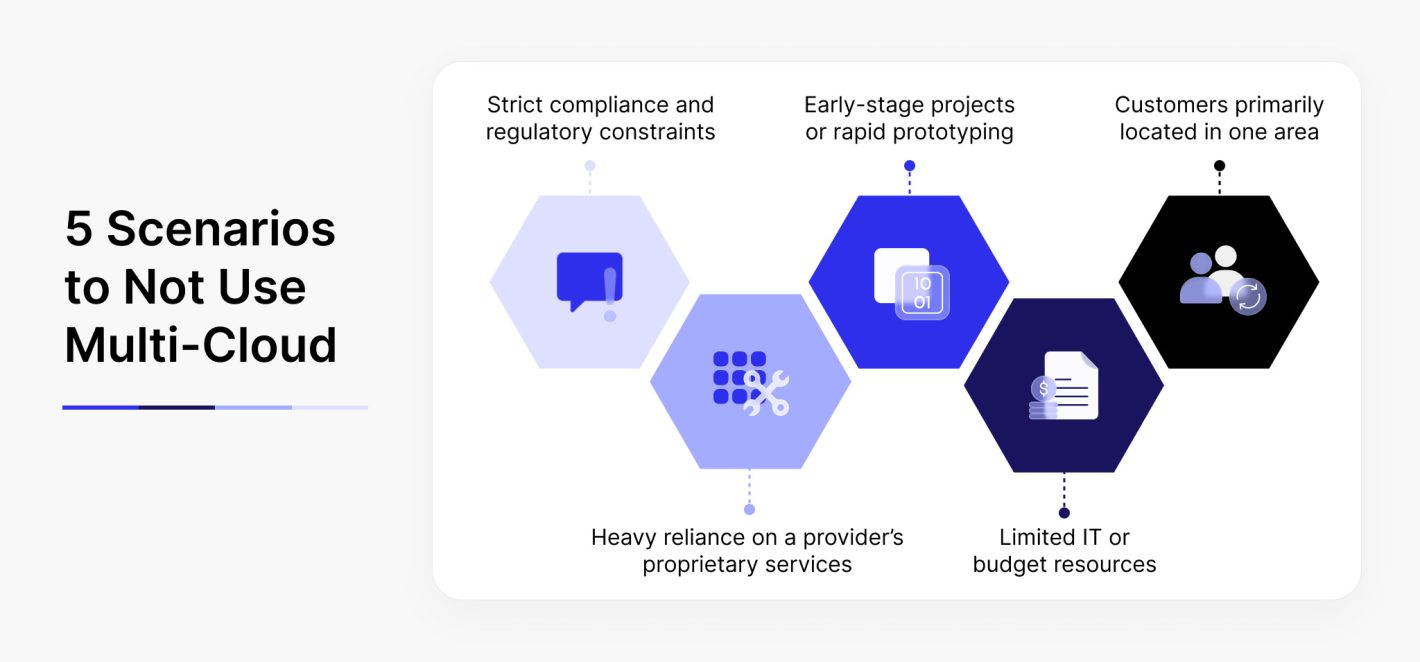


Five scenarios not to use multi-cloud
Strict compliance and regulatory constraints in regulated industries
In industries like finance, it might be hard to keep data in very specific jurisdictions or even use specific cloud provider services.
Heavy reliance on a provider’s proprietary services
Heavy reliance on a cloud’s specialized offerings (e.g., AWS Lambda, Azure Cognitive Services, or GCP’s BigQuery) might make it difficult for an organization to replicate or migrate these capabilities to other providers.
Early-stage projects or rapid prototyping
Startups or innovation teams working on greenfield projects often prioritize speed and simplicity over architectural flexibility.
Limited IT resources and budget
Managing multiple platforms might turn into a challenge for smaller businesses or teams with limited budgets and specialists.
Your customers are primarily in one region
There’s no need to complicate things if your application’s availability and performance requirements are met with a single provider when your users are located mostly in one region.
Real-World Case Studies: Multi-Cloud Simplification in Action
To better understand how businesses navigate multi-cloud complexity, let’s examine two real-world cases we were engaged in as a cloud software development company.
Use case 1: Our client, a telecommunications service provider, operates its primary infrastructure on AWS but manages all data engineering tasks on Google Cloud Platform (GCP). The need for specialized data analytics tools drove the decision to split workloads between these providers. Google BigQuery and Dataflow provide advanced capabilities for scalable data processing, which align with the company’s analytics-driven operations.
Additionally, GCP’s pricing model provided a more cost-effective solution for handling large-scale data workloads. The data team’s prior experience with GCP further influenced the company’s decision to adopt a hybrid approach, ensuring a smooth transition and optimal performance across platforms.
Use case 2: An American flooring company hosts its core infrastructure on Google Cloud Platform (GCP) but has chosen to store its database backups in AWS S3. This strategic decision aims to reduce reliance on a single cloud provider and improve disaster recovery preparedness.
By diversifying storage locations, the company mitigates risks associated with potential availability zone failures within GCP. This arrangement ensures that essential business data stays accessible and secure, even during unexpected interruptions. The combination of GCP’s computing capabilities with AWS’s reliable storage solutions allows the client to maintain operational resilience while optimizing cloud costs.



Conclusion
Revisiting the opening argument, multi-cloud strategies enhance business agility, mitigate risks, and optimize budgets; however, they necessitate robust governance, observability, and automation.
As an IT leader, here’s what you should consider doing to simplify the tangled mess of a multi-cloud:
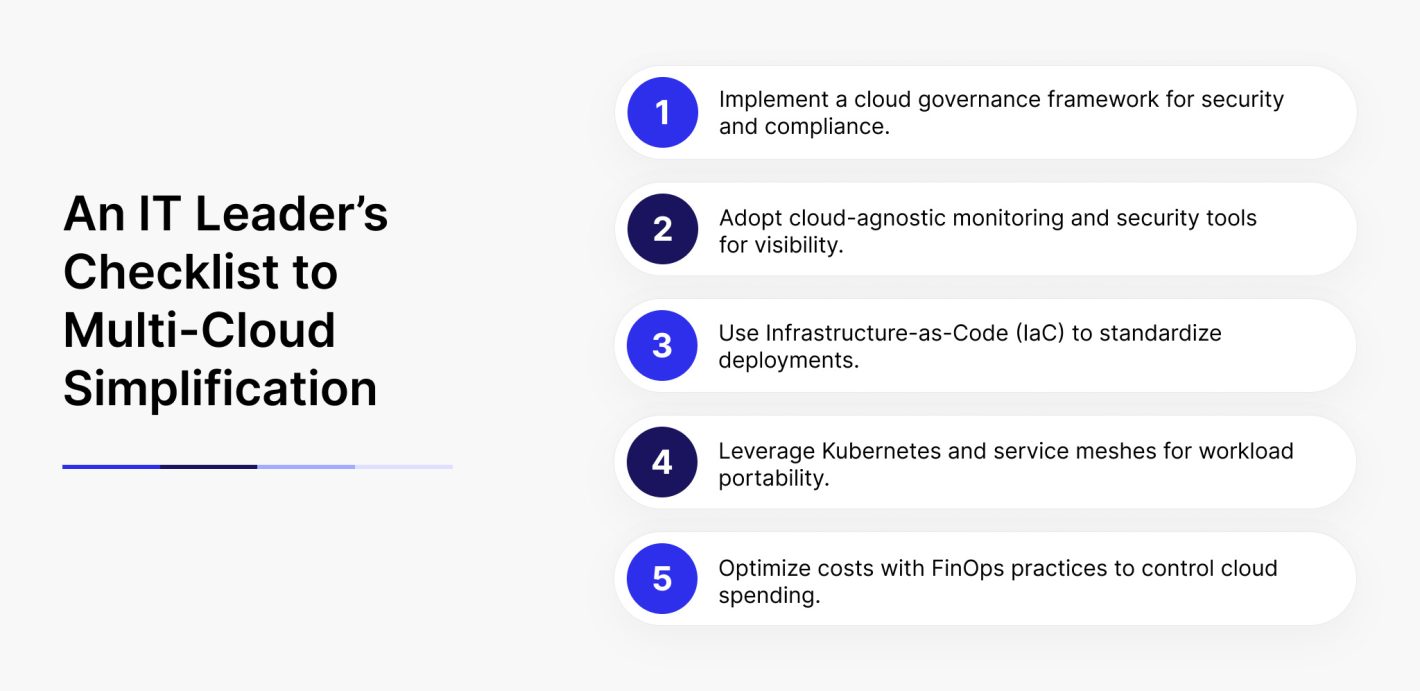


Multi-cloud simplification checklist
At Sombra, we help businesses manage multiple IT environments efficiently. Our expertise covers the cloud domain, including cloud consulting, automating infrastructure setup through Infrastructure as Code (IaC), and conducting cloud infrastructure assessment and management.
Is your multi-cloud strategy costing you more than it should? Contact Sombra’s experts for a free consultation today.


